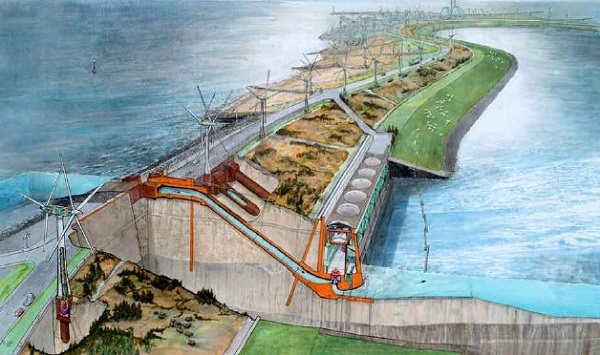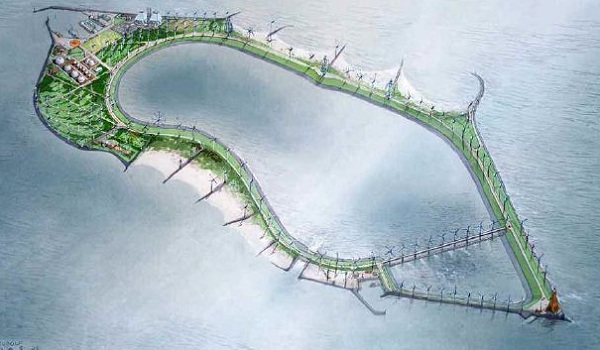It’s one of the wildest schemes we’ve heard for storing wind energy and the government in Belgium says the country might actually go for it.
The plan: Build an island a few miles offshore in the North Sea with a below-sea-level reservoir, protected by dikes, in the middle of it. When there’s more wind power than needed (often the case during the overnight hours), pump the water out of the reservoir. When there isn’t enough wind power, open the floodgates and let water rush into the reservoir, spinning power-producing turbines along the way.

Belgium’s North Sea minister, Johan Vande Lanotte, told Reuters last week that the country will pursue this plan just as soon as it improves the grid connection leading up to the coast. The project itself would have a five-year development timeline.
Beyond the fact that it the island would “be built out of sand 3 km off the Belgian coast near the town of Wenduine if it gets the final go-ahead,” details on the precise Belgian plan were hard to track down. But in searching for info we were surprised to find this concept isn’t new.
In 2007, the Dutch consulting company DNV KEMA and engineering firm Lievense outlined an “Energy Island” in a paper that’s on the DNV KEMA website. Check out the PDF.

These guys dubbed the scheme an “inverse pump accumulation station” – inverse because it’s a switch on the usual pumped hydro method for storing wind and other forms of energy. Under existing operations, water is pumped up hill during periods of low demand. Then when power is needed, the water is released down the hill through turbines that drive electricity-producing generators.
In the Energy Island scenario outlined by the Dutch companies, the reservoir would be dredged to a depth of 50 meters below sea level and protected by a ring of dikes. Dikes are something the Dutch have a long familiarity with, of course, but even so, these companies admitted making an impermeable reservoir would be a challenge. “One great uncertainty in the concept, is seawater leakage into the reservoir,” they wrote, but thick clay layers off the Netherlands coast and bentonite walls down to 60 meters would do the trick, they said.
The Reuters story didn’t explore the capacity of the Belgian idea, but the Dutch companies were talking about a reservoir running 10-by-6 kilometers. That’s 23 square miles, a big hole, to say the least, and capable of “storing” 30 gigawatt-hours of electricity, according to the Energy Island paper. That means an empty reservoir could offset the production of a large power station (say, 1,500 megawatts) for the better part of a day as it fills up with seawater.
The Belgians, according to the Reuters story, are pursuing this project because they want to add thousands of megawatts of North Sea wind capacity to their grid to replace at least some of the nuclear power that now meets more than half the country’s energy needs.